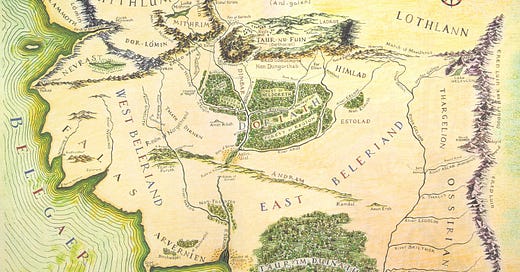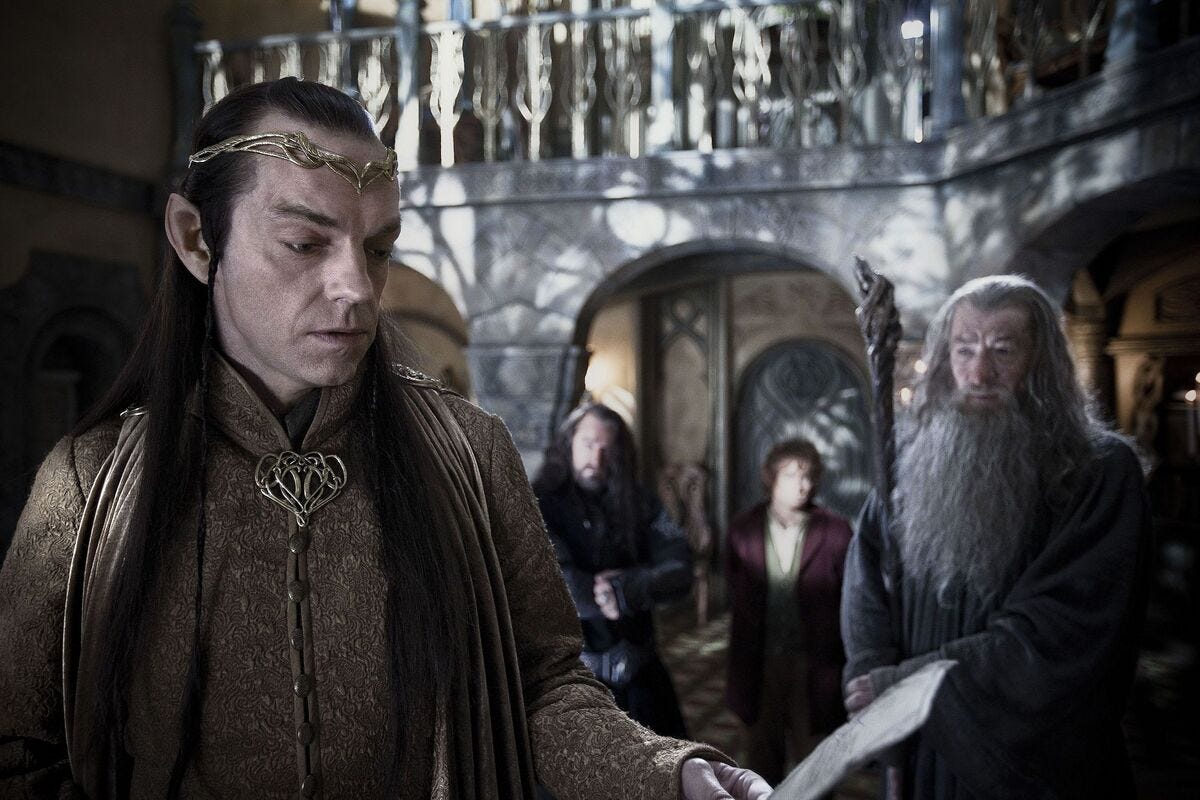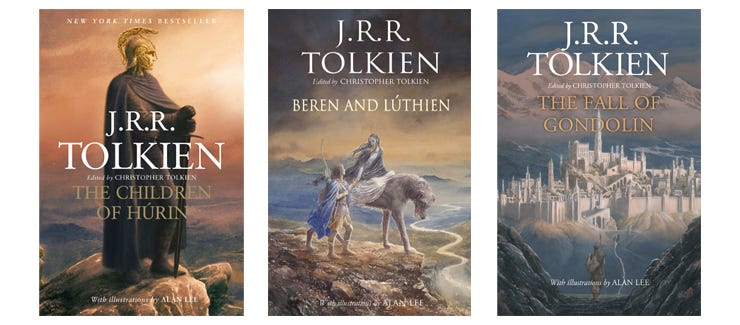🗺️ Exploring the Lore of Middle-earth: A Practical Guide
The Hobbit, The Lord of the Rings, and Beyond
Is there any better feeling than cracking open a new book to reveal a map of a strange new world inside the front cover? The sense of wonder, excitement, possibility, and adventure that a new map filled with strange names and fantastic new places evokes is one of the best parts of starting a new fantasy book. Over the course of the journey from cover to cover, this map transforms from an intriguing and mysterious stranger into a well-known and familiar friend.
But sometimes the beginning of a journey like this can be overwhelming. Where to even begin? How to interpret all the strange names and symbols on the map? Will the required investment of time and effort be worth it in the end? And that’s when there’s only one book or series to familiarize oneself with. What happens if there are numerous books and series spanning thousands of years of in-universe history that take place on a multitude of different maps?
J.R.R. Tolkien’s Middle-earth is one such world that can be intimidating to the uninitiated. While those who have put in the work to become familiar with the world of Arda and the stories that take place therein reap the benefits of their hard-won mastery of Tolkien’s Legendarium, those just beginning the journey face a potentially daunting expedition ahead of them. Perhaps you’ve heard horror stories of multiple failed attempts at reading The Silmarillion. Or maybe you didn’t even know there were other books aside from The Lord of the Rings and The Hobbit and are overwhelmed by the knowledge that there are dozens of volumes of additional material to sift through.
When faced with a task that is seemingly beyond us, sometimes what is needed is a guide. We need someone who can decipher the map’s secrets because they have already been where we wish to go.
That’s why I’m writing today. If you’ve ever wanted to take your first steps into the wider world of The Lord of the Rings or go deeper into the history and lore of Middle-earth, today’s newsletter is for you.
I’ll be providing some recommendations for what to read next for various types of readers of Tolkien, depending on which of his works (if any) you may have already read. Perhaps you’ve seen one of The Lord of the Rings or The Hobbit adaptations on film or Amazon’s The Rings of Power, but haven’t yet read any of the books and are wondering where to begin. Maybe you’ve already read one or both of The Hobbit and The Lord of the Rings but aren’t sure what else is out there by Tolkien to read. Or maybe you’ve read all three of those and still want to continue exploring Tolkien’s legendarium. Wherever you find yourself on this spectrum of experiences, I’ve got some recommendations for you.
So where will your journey deeper into Tolkien’s writings take you? Let’s set out together.
If you’ve seen some or all of The Lord of the Rings or Hobbit movies but have never read the books
then I’d first like to congratulate you on beginning an exciting adventure! I absolutely love so many of the adaptations of Tolkien’s works on the big and small screens, but ultimately they are all interpretations, and experiencing the books for yourself is worthwhile and commendable. There are certain aspects of these stories that simply cannot be experienced any other way.
If you haven’t read any of Tolkien’s works, then I would suggest beginning with The Hobbit. In many ways it is different from the rest of the books on this list. It is a children’s book (it started out as a bedtime story that Tolkien told his children) and its narration and tone is often cheeky and whimsical. It has relatively little to do with the grand, overarching mythical and historical narratives of The Silmarillion–or even specifically with the story of Sauron and the Rings of Power–except for a magic trinket that a halfling burglar named Bilbo Baggins finds along the way.
That said, it’s a wonderful story and serves as an excellent introduction to the wider world of Middle-earth. You will meet dragons and spiders and wargs and goblins. You will not only be introduced to the races of Men, Dwarves, Elves, and Hobbits, but also begin to become acquainted with their long histories and (at times) strained relationships. You will meet the wizard Gandalf and hear whispers of a Necromancer at the edges of the story who hints at a dark threat looming in a much larger world .
It’s a very manageable read as well, so you’ll start off your journey into the pages of Middle-earth getting a taste for the wider world while also accomplishing something noteworthy (you’ve finished a book of Tolkien’s!) before too long.
After reading The Hobbit, read The Lord of the Rings next.
LOTR is a longer work with a more serious tone and formal style of writing. It will take longer than the Hobbit and is a bit more demanding. It is a step up in these regards but is completely worth the effort and still very doable.
There are many differences between the movie adaptations of these works and the novels. Some differences are positive changes that make sense for translating the story to a different medium. As for the others…well, they may have their defenders but they are still WRONG (*cough* Justice for Faramir *cough*). Reading the books will both give you a new and deeper experience of these stories as well as hopefully increasing your appreciation for the things the adaptations did well.
If you’ve read The Hobbit and The Lord of the Rings but nothing else of Tolkien’s, then my recommendation is to continue on to The Silmarillion.
The Silmarillion covers the major events of the First Age of Middle-earth (The Hobbit and The Lord of the Rings are set in the Third Age).
This is it: the Bible of Middle-earth. From the creation of the world of Arda to the Third Age and beyond, this is the tome that captures the epic scope and history of Middle-earth. It’s no small feat to read The Silmarillion, as this classic meme illustrates:
Don’t let me scare you off though. You can and should read The Silmarillion if you’ve read The Hobbit and The Lord of the Rings and are hungry for more from the world of Middle-earth! Here are some ideas and tips for reading The Silmarillion that may help you as a first-time reader:
Accept that you’re not going to keep track of every character and that’s okay. Focus on the main players and action. Consult the family trees included in the book to help. TolkienGateway, an online J.R.R. Tolkien wiki, is your friend too.
Make use of free resources like The Silmarillion Reader’s Guide by TeaWithTolkien or reading groups that are going through The Silmarillion together to help you understand and keep track of what’s going on in each chapter.
Find a friend to take the reading journey alongside you for some encouragement and accountability.
Remember it’s okay to take a break or walk away completely. Not every book is for every person, and if you enjoy The Hobbit and LOTR but just aren’t feeling it with The Silmarillion, that doesn’t make you any less of a fan! It took me multiple tries myself to finally conquer this one.
I’m currently in the middle of a re-read this year, so I can definitely say I enjoyed it enough that I’m coming back for more. I found reading The Silmarillion to be totally worthwhile, and discovered my appreciation for and love of these stories has only deepened as time has gone by.
You’ve conquered The Silmarillion: Now what?
First of all, well done! You’ve achieved something here that not everyone does!
The next time you reread The Lord of the Rings, that story will be richer because of your deeper understanding of the connections to the broader narrative and history of Tolkien’s universe. You’ll understand the importance of Aragorn’s lineage, the importance of Tuor and Eärendil to Galadriel’s gift to Frodo, and countless other references Tolkien includes throughout the story.
Where you go next depends on your interests. One path is to delve deeper (though not too greedily) into the process of composition and development of Tolkien’s entire body of work, including the most minute of details and the lengthiest of histories. Another option is to stick with narratives for a bit longer.
For the Narratives
Read The Children of Hurin, an extended edition of the same story from The Silmarillion. It’s much expanded and the last of Tolkien’s stories after The Hobbit, The Lord of the Rings, and The Silmarillion to be published in a “final” or complete form.1
As you probably remember if you’ve read the version from The Silmarillion, it’s a tragic tale full of hubris, betrayal, and doom. It’s an excellent and well-crafted story that fills in the details of the shorter version in The Silmarillion and gives the narrative time to develop and breathe.
But perhaps you’re not looking for an expanded version of a story you’ve already read and are more interested in a peek behind the curtain at the development of the saga. What you’re after is the lore and legends of Middle-earth.
For the Lore and Legends
Just like the directors commentary and behind-the-scenes features of Peter Jackson’s The Lord of the Rings trilogy give a look at the process of bringing the films to life, many of Tolkien’s other works give a look at the composition history of Tolkien’s many works in their various forms and stages of development. Like The Silmarillion, they were edited and published after his death by his son Christopher.
There are a number of collections of these various versions of the tales of Middle-earth. The first category are single-volume books that each focus on one of the three major narratives found in The Silmarillion of which Tolkien wrote extended treatments: The Fall of Gondolin, The Children of Húrin, and The Tale of Beren and Lúthien.
These three stories, referred to as the “Great Tales” of the First Age of Middle-earth, are simultaneously close enough to complete that they can stand on their own, but also went through multiple versions over the course of Tolkien’s life.
As mentioned above, The Children of Húrin was published as a single expanded narrative. However, The Fall of Gondolin and The Tale of Beren and Lúthien take a different approach. Unlike The Children of Húrin, various factors made it nearly impossible to construct a ‘final’ version of these stories out of the myriad versions Tolkien wrote. Therefore, instead of a single narrative these volumes present in chronological order the various forms of these stories Tolkien wrote, and include commentary on them by his son and editor, Christopher Tolkien.
The second category of collections of tales of Middle-earth are collections of Tolkien’s writing that focus not on a single story but more generally on his entire body of work.
One example in this category is a single volume called Unfinished Tales of Númenor and Middle-earth. As the title suggests, it is a collection of unfinished stories such as an alternate version of the death of Isildur and the loss of the One Ring, the coming of Gandalf and the Istari to Middle-earth, the establishment of Rohan, how Gandalf met and recruited Thorin and the other dwarves prior to the story of The Hobbit, and Galadriel and Celeborn’s history.
Then there is the 12-volume History of Middle-earth (collected in three-volume hardback but also in individual paperback volumes), a massive library of texts that tells in exhaustive detail not the internal history of Middle-earth itself but the history of the development of Tolkien’s Middle-earth over the course of his life. It’s fascinating and all-encompassing, the ultimate destination for the reader who wants to know all there is to know about Middle-earth.
If you’ve watched Amazon’s The Rings of Power and would like to learn more about Númenor specifically, you have a few options.
You could either read The Silmarillion in its entirety, or read only the section specifically referencing Númenor—the Akallabêth (“Downfall”)—or you can read The Fall of Númenor, which collects most all of the information about the Second Age and Númenor, Sauron, and the Rings of Power from throughout The History of Middle-earth and Unfinished Tales in one volume.
Finally, what to read if you need a break from Middle-earth but not from Tolkien
If at any point you need a break from the stories of Middle-earth but still want to stick with Tolkien, he has more to offer! Chief among them in my opinion are his essay “On Fairy-stories” and short allegory “Leaf by Niggle,” both of which you can find in Tree and Leaf.
The Road Goes Ever On
I hope that this guide will serve you well as a map of a kind to Tolkien’s published works. Whether you’re someone who hasn’t read a page of Tolkien or someone who has read some of his works but would like to explore his Legendarium further, I hope you found a next step or two in this discussion of Tolkien’s work. Whatever that next step is, let me encourage you to take it! After all, as Bilbo tells Frodo about stepping out of your door, “there’s no knowing where you might be swept off to.”
Appendices
All the links above take you to Amazon. However, if you’d like to support your local bookstore instead, I have compiled almost all of the same titles in a list on Bookshop.org. Your purchase there will support the local bookstore of your choice!
Special shout-out and thank you to Sonya H who upgraded to a paid membership to the Jokien with Tolkien: Extended Edition this week! This is a reader-supported newsletter and Jokien with Tolkien: Extended Edition members help keep it coming to everyone’s inboxes week in and week out. If you too regularly get value, entertainment, encouragement, or inspiration from this newsletter, consider upgrading your subscription.
Yesterday was the one-year anniversary of my brother’s death. I wrote a newsletter this past March where I examined the wounding, grief, and loss in the story of Frodo and Sam at the end of The Return of the King. If you haven’t read it (or would like to again), I’d be honored if you did:
⚔️ Join 5,000+ subscribers in the Jokien with Tolkien community: Subscribe here
🏹 Chosen as a Substack Featured Publication in 2023
🪓 Official merch available in the Jokien with Tolkien store
❌ All typos are totally on purpose
🔗 Links may be affiliate, which is a free-to-you way to support this newsletter where I earn a small commission on items you purchase
🗃️ Can’t wait till next Thursday for more content? View the archive
🎯 Interested in sponsoring this newsletter? Email me at JRRJokien@JRRJokien.com
Like The Silmarillion, The Children of Húrin was published after J.R.R. Tolkien’s death and edited by his son, Christopher. You absolutely could read it before The Silmarillion if you wanted to stick more to a single story instead of The Silmarillion’s epic scope. You could also try it if you have tried to read The Silmarillion a few times and just can’t get through the early parts. Who knows: it might motivate you to go finish The Silmarillion if you really enjoy it!











I have to say, this really clarifies for me the many different ancillary LOTR-related texts. I myself am now becoming more and more interested in both The Silmarillion and the History of Middle-earth series. Then there are the expanded Letters of JRR..... Honestly, it's amazing how much stuff exists outside the core novels.
highly recommend “on fairy stories” and “leaf by niggle”! they were required reading in a uni english class, and now i go back frequently to reread them both.